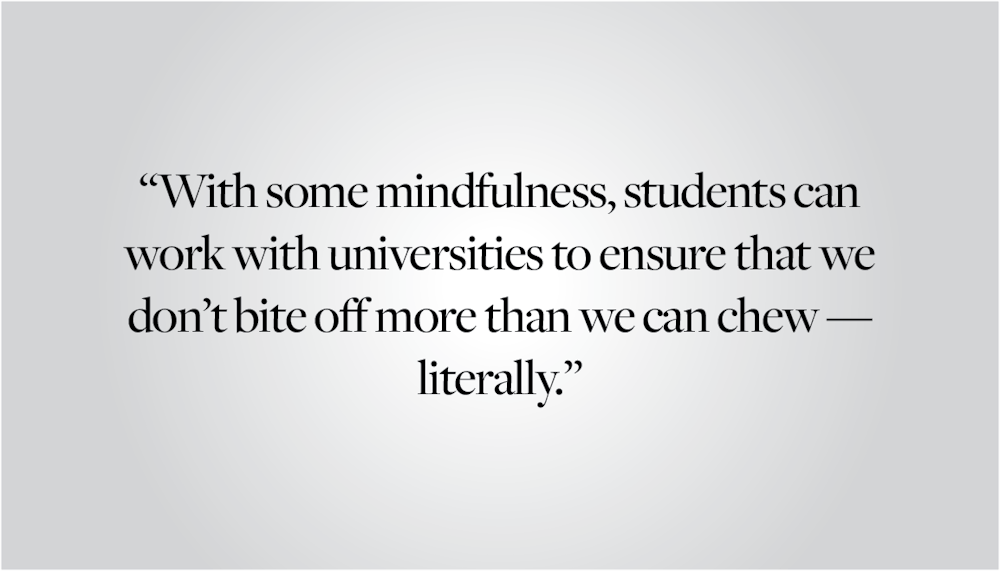We’ve all been there: the Sharpe Refectory’s having a themed dinner night, and there are so many options to choose from. You visit the comforts line, soup kettles and dessert bar until suddenly you look down at your towering plate of food and realize you’ve taken far too much. You eat what you can, and a mound of leftovers is forked into the compost bin.
It’s no secret that Americans waste a lot of food: The United States Department of Agriculture’s Economic Research Service estimated in 2010 that the U.S. wasted approximately 133 billion pounds of food — approximately 30% to 40% of its food supply. College campuses are major contributors, throwing out an estimated 22 million pounds of food each year. Not only is this environmentally unsustainable — it also encourages the development of poor eating habits in college students. Much more effort is needed from students and universities to curb America’s food waste habit.
Food waste contributes to environmental harm through all phases of the food supply chain. When food goes to waste, the land, water and animal feed used to grow that food is also wasted. For instance, throwing away one pound of beef means throwing away 1,800 gallons of water. Additionally, energy used to store and transport food to distributors and supermarkets is also wasted when food is discarded. On the consumer side of food production, food waste rotting in landfills contributes to methane and carbon emissions.
Food waste along the supply chain is also cumulative: Waste further down the supply chain carries more intensive environmental impacts. Throwing away an apple from the dining hall, for example, also wastes all the resources used to grow, package, store and distribute the apple. The waste resulting from simple decisions like this is concerning without even considering the monetary loss from spending money on wasted food. But without any immediately visible consequences from wasting food, the impact seems far less tangible, contributing to the continuation of the damaging practice.
College life, in particular, makes wasting food easy. While swiping into a dining hall is simple and gives diners more food options, this easy access to food may inhibit a student’s food-management skills. One study at the University of Illinois interviewed a participant who acknowledged that “in the dining halls it’s (really easy) to take a lot of food and then just throw away whatever you don’t eat.” Without awareness of the importance of portion size and the value of food, it could be more difficult for students to minimize food waste in the future. College-aged students are still forming long-term eating behaviors, so shaping food-wasting habits early on could reduce the likelihood of continued waste in the future.
Thankfully, many colleges are working to reduce food waste on campus. One of the most common interventions is removing trays from the dining halls to make it more difficult for students to grab too much at once. For example, Rutgers University saved $300,000 in food costs and reduced food waste by 20% just by scrapping trays. Reducing plate size in college settings may also reduce individual plate waste. Many colleges including Brown, Harvard and Cornell have also committed to composting food waste to reduce greenhouse gas emissions.
Despite these interventions, food waste still remains a profound issue on college campuses and should be considered an ongoing problem requiring multilevel solutions. For example, food waste at the Ratty could be reduced by using smaller or oval-shaped plates. Flyers in the dining hall explaining the impact of food waste could also deter students from taking more food than necessary. Closely monitoring the amount of trash and conducting interventional research could also help Brown find the best strategy to reduce food waste.
Individual awareness can also reduce food waste on campus. It can be tempting to take the phrase “all-you-can-eat” too seriously (Brown, to its credit, uses the phrase “all-you-care-to-eat”) when presented with a seemingly boundless amount of food in dining halls, but being intentional about our plating habits can help us eat in a more environmentally friendly fashion. With some mindfulness, students can work with universities to ensure that we don’t bite off more than we can chew — literally.
Juliet Fang ’26 can be reached at juliet_fang@brown.edu. Please send responses to this opinion to letters@browndailyherald.com and other op-eds to opinions@browndailyherald.com.
Juliet Fang is a second year at Brown studying Ecology and Evolutionary Biology. In her free time, she enjoys running, cycling, and watching duck videos.



